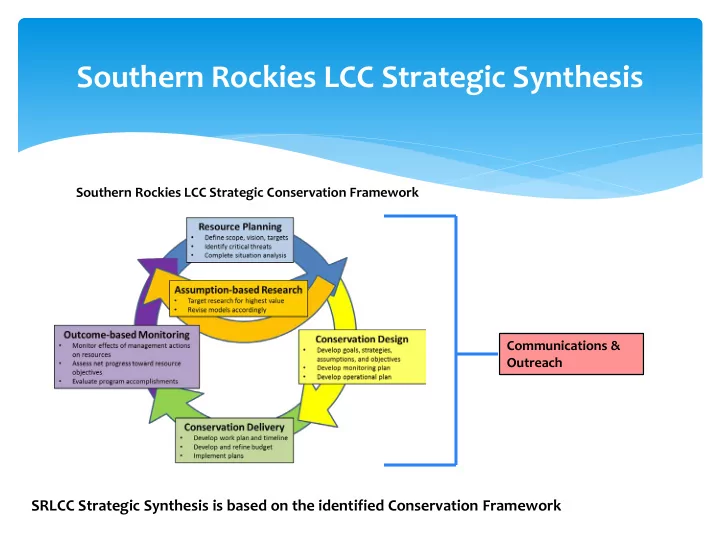

Southern Rockies LCC Strategic Synthesis Southern Rockies LCC Strategic Conservation Framework Communications & Outreach SRLCC Strategic Synthesis is based on the identified Conservation Framework
Proposed Strategy Goals CONSERVATION/BIOLOGICAL PLANNING Proposed Goal 1: The SRLCC will provide the structure and processes needed to collaboratively identify, co-develop, and integrate scientific information to support landscape conservation priorities. Proposed Goal 2: The SRLCC will support the articulation of desirable conditions for Focal Resources at the landscape-level.
Proposed Strategy Goals CONSERVATION DESIGN and DATA MANAGEMENT Proposed Goal 3: The SRLCC will create and deliver landscape-level data sharing strategies, syntheses and integration tools for discoverable, accessible, and useable data that leverages and supports resource management decisions related to SRLCC landscape conservation priorities. Proposed Goal 4: The SRLCC will facilitate the Landscape Conservation Design process and provide tools for integration of biological, social, and economic factors into effective landscape-level planning and climate adaptation responses which include identifying places and actions that help achieve collaboratively-developed resource management goals.
Proposed Strategy Goals CONSERVATION DELIVERY Proposed Goal 5: The SRLCC will develop the appropriate tools , decision support, and communication platforms to facilitate strategic and coordinated conservation delivery for on-the-ground resource management. OUTCOME BASED MONITORING Proposed Goal 6: The SRLCC will develop the appropriate metrics and methodologies that enable our member organizations and partners to collaboratively evaluate our collective progress in delivering sustainable natural and cultural resource management.
Proposed Strategy Goals ASSUMPTION DRIVEN APPLIED RESEARCH Proposed Goal 7: The SRLCC will work with our partners and other organizations (such as Climate Science Centers, USDA Climate Hubs, RISA’s and other LCCs) to develop a robust science agenda that employs the principles of adaptive management on a landscape-scale, and which defines a future conservation landscape capable of sustaining natural and cultural resources at desired levels. COMMUNICATION AND OUTREACH Proposed Goal 8: Facilitate engagement and dialogue across the SRLCC geography that attracts partners, supports existing and new project funding, improves partner relations, and raises awareness of SRLCC activities.
A table has been developed for each goal using a basic logic model that defines OBJECTIVES, ACTIONS, OUTPUTS, and OUTCOMES CONSERVATION/BIOLOGICAL PLANNING Proposed Goal 1: The SRLCC will provide the structure and processes needed to collaboratively identify, co-develop, and integrate applied scientific information to support landscape conservation priorities. OBJECTIVES ACTION OUTPUT OUTCOMES 1. LCC Staff and Steering Committee are 1. SC members engage with their organization and staff Enhanced Situational Context of conservation Builds capacity to address o o actively fostering strategic engagement, to identify ways SRLCC can help meet their needs actions on the landscape (who is doing what/how conservation needs across collaboration, and coordination with a diversity of and are bringing this information back to SC.. partners are interacting) the larger landscape entities that influence landscape conservation decisions, including: state and federal agencies, 2. Using completed social network analysis/mapping, Define gaps/needs for Steering Committee Allows measurement of o o tribes, Universities, NGOs, regional partnerships identify key outreach needed to further connect local membership SRLCC engagement with and regional and local planners. and regional partnerships to enhance SRLCC other partnerships and the landscape conservation planning efforts Identification of priority activities/projects for effectiveness of SRLCC in o Traditional Knowledge integration associated with supporting regional 3. SC Evaluates current membership and make up, and SRLCC focal resources conservation efforts identifies potential new members for inclusion. Enhanced collective approach (knowledge More tribes actively o o 4. Integrate new partner priorities as they emerge integration) to resource conservation and adaption participate with the planning SRLCC 5. On-going support and implementation of SRLCC activities/resources Tribal Engagement Strategy Identification of actions SRLCC can take to support o tribal conservation efforts SRLCC is operating in o value-added capacity 2. The LCC has organized the technical capacity, 1. Coordinator articulates the strategy and structure Identification and validation of key information SRLCC has an objective o o including dedicated partner staff, needed to for science acquisition/use for focal areas. needs basis for identifying and address priority conservation science needs. prioritizing science Further, the LCC has established a working 2. Science Coordinator implements strategy for Identification and validation of key science needs investment funding/ needs o relationship with organizations that provide science acquisition/use in focal areas. research, information and tools (e.g., RMRS, Identification and validation of key stressors on the Consolidated information o o USGS, USDA, Heritage Programs, CESUs, etc.) 3. Integrate existing focal priorities into focal area landscape about science and/or to ensure that science and conservation activities adaptation forums, and adopt new priorities that processes that reduces involving the LCCs have access to the best emerge as priorities within one or more focal area. Focal areas are actively moving through the duplication of effort by o regional technical information and that priorities Strategic Conservation Framework utilizing LCD partners for identified are coordinated and integrated. 4. Technical capacity reviews needs expressed by priority conservation each focal area, looking for duplications and if data SRLCC science or technical teams are addressing targets o already exists. Provides recommendation to SC for the LCC’s priority conservation science needs. moving forward with projects. FOAs/RFPs based on highest priorities o
PLAN FOR STEERING COMMITTEE REVIEW Steering committee will have 1-2 conference calls to provide initial feedback/edits/comments on draft goals and associated Objectives/Actions/Outputs/Outcomes (*especially want to build consensus on the level of detail for actions) prior to July meeting Two weeks prior to July meeting, the SC will receive revised Goals and Tables based on feedback from conference calls SC will provide final feedback on revised goals/goal tables at the July meeting and vote to adopt Volunteers will also be requested at the July SC meeting to form another short-term workgroup to develop draft performance measures for the finalized goals and objectives The Strategic Synthesis Workgroup will prepare remaining text for the plan and a final, completed draft strategy will be provided to the SC at least two weeks before the November 2017 meeting
Recommend
More recommend